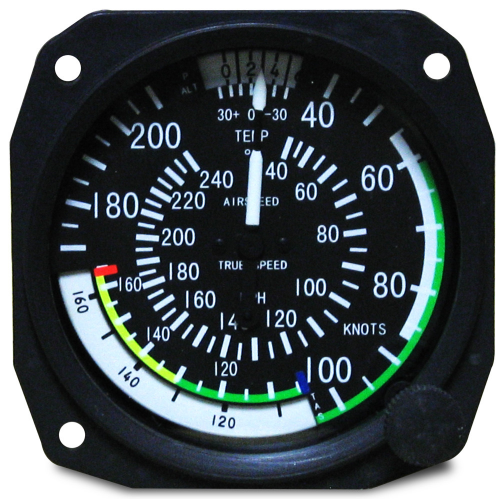Airplanes only create lift within a certain speed range, so to maintain flight, a pilot has to fly between minimum and maximum speeds.
Just reading the airspeed off of the Airspeed Indicator doesn’t give the full picture, however.
There are inherent accuracies in the Airspeed Indicator itself, as well as other conditions that make the reading inaccurate.
Installation issues, indicator issues, temperature, air density, and wind velocity can all affect airspeed readings and accuracy.
There is no need to be alarmed, however.
Throughout this article, we’ll be talking about the 5 different types of airspeed, which include:
- Indicated Airspeed (IAS)
- Calibrated Airspeed (CAS)
- Equivalent Airspeed (EAS)
- True Airspeed (TAS)
- Groundspeed (GS)
Keep reading to see how to adjust accordingly for an accurate picture and a safe flight.
What is Indicated Airspeed (IAS)?
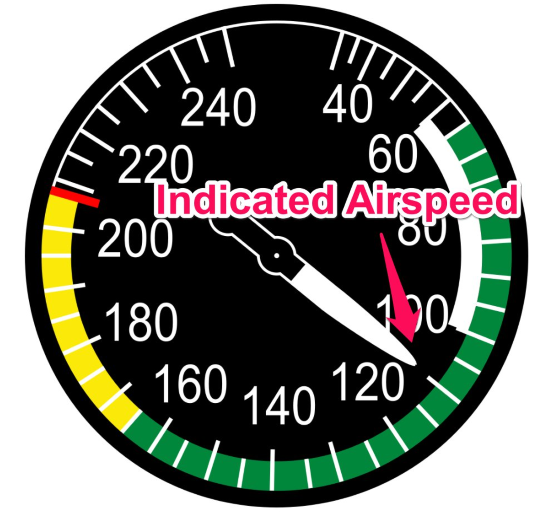
Indicated Airspeed (IAS) is the reading directly off of the Airspeed Indicator.
It is uncorrected for installation and instrument errors, along with changes in air density.
Aircraft manufacturers use Indicated Airspeed as the basis of takeoff, landing, and stall speeds as listed in the Pilot’s Operating Handbook (POH).
Indicated Airspeed is a good “ballpark” estimate for airspeed, but there needs to be more corrections in place to increase the accuracy of the reading, depending on conditions.
Related Article – Airspeed Indicators Explained
What is Calibrated Airspeed (CAS)?
Calibrated Airspeed (CAS) is the IAS corrected for installation error and instrument error.
No mechanical device is 100% accurate, and sometimes manufacturing tolerances and installation issues “stack”, adding to a measurable error.
Under certain flight conditions, like slow flight, or with flaps deployed, the error can be several knots.
At cruising speed and higher airspeeds, IAS and CAS are approximately the same.
It is not possible to eliminate all errors, however, many airplanes use an airspeed calibration chart to determine the difference between IAS and CAS.
Alternatively, you can use the below equation to calculate calibrated airspeed:

- qc = Impact pressure
- P0 = Standard pressure at sea level.
- a0 = Standard speed of sound at 15 degrees Celsius.
Indicated Airspeed (IAS) vs. Calibrated Airspeed (CAS)
Indicated Airspeed is the reading taken directly off of the airspeed indicator, while Calibrated Airspeed is the IAS corrected for instrument and installation error.
The difference is usually noted in an airspeed calibration chart, and at normal cruising speed, is usually around a knot or two.
What is Equivalent Airspeed?
Equivalent Airspeed (EAS) is CAS corrected for the compressibility of air at a non-trivial Mach number.
It is also defined as the airspeed at sea level, under International Standard Atmosphere (ISA) conditions, at which dynamic pressure is the same as the dynamic pressure at the TAS and altitude at which the aircraft is flying.
Simplifying the nerd-speak, air is compressible, but at low airspeed and altitudes, air can be treated as incompressible.
Therefore, below approximately 200kts and 10,000ft MSL, the difference between CAS and EAS is negligible.
At higher speeds and altitudes, CAS must be corrected for compressibility error to determine EAS.
This is mostly important for fast, high performance aircraft.
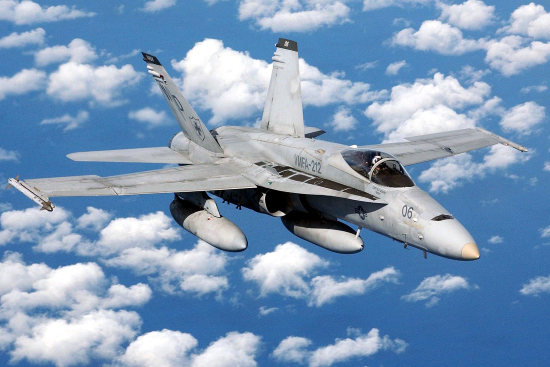
What is True Airspeed (TAS)?
True Airspeed (TAS) is CAS corrected for altitude and nonstandard temperature.
Air density decreases as altitude and temperature increase, therefore, the pitot tube detects less dynamic pressure as density decreases.
This means that, for a given CAS, TAS increases as altitude increases, and vice versa.
TAS can be determined by entering CAS temperature and pressure altitude into a flight computer.
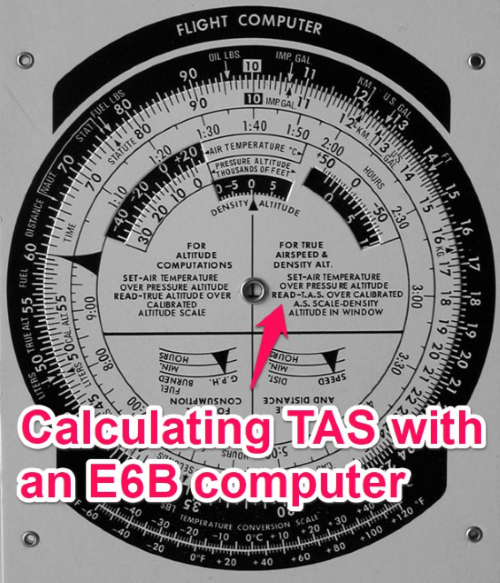
If that is unavailable, a rule of thumb is to add 2 percent to the CAS for each 1,000ft of altitude.
TAS is used when filing a flight plan.
Equivalent Airspeed (EAS) vs. True Airspeed (TAS)
TAS is EAS adjusted for air density, which is affected by atmospheric pressure and temperature.
At lower airspeeds and altitudes below 10,000ft MSL, EAS is approximately equal to CAS, therefore TAS will generally be a bit higher than EAS/CAS.
What is Groundspeed?
Groundspeed is the actual speed of the airplane over the ground.
Wind direction and speed affects the groundspeed.
If an airplane is flying with a headwind, the groundspeed will be lower than the true airspeed.
If an airplane is flying with a tailwind, the groundspeed with be higher than the true airspeed.
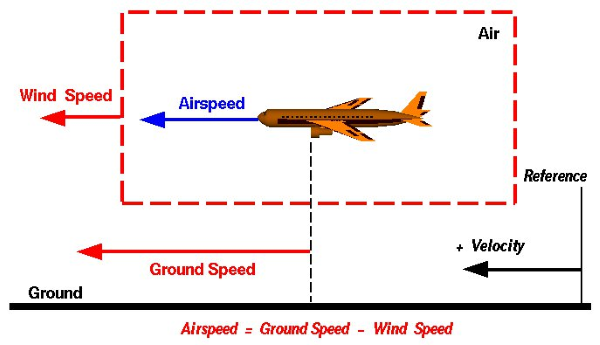
Knowing winds aloft is a critical part of flight planning.
Picking an altitude with favorable tailwinds can dramatically reduce flight time.
Conversely, picking an altitude with the lowest headwinds can be critical for safety, as a strong headwind reduces range, possibly requiring an extra stop for fuel.
Related Article – Aircraft Altimeters Explained
True Airspeed (TAS) vs. Groundspeed
True Airspeed is the speed at which the aircraft is flying through the air.
Groundspeed is the speed the airplane is moving in relation to a point on the ground.
For example, if a plane is flying at 120kts TAS and encounters a 20kt headwind, the groundspeed is 120-20kts, or 100kts.
Conversely, if the plane is flying at 120kts TAS with a 20kt tailwind, the groundspeed is 120+20kts, or 140kts.
The reason TAS is used for flight planning is because groundspeed can change along a flight path, but it is still important to understand the implications of head/tailwinds on groundspeed.
While arriving at your destination sooner than planned is always great, running out of fuel because of a strong headwind will ruin your day.
Types Of Airspeed Summary
Airspeed is not just taking the reading directly off of the airspeed indicator. That only shows Indicated Airspeed (IAS).
Many other factors affect airspeed readings and definitions, such as indicator/installation error, temperature, dynamic pressure, and compressibility.
Calibrated Airspeed (CAS) is the airspeed corrected for instrumentation and installation error, and is normally referenced in an airspeed calibration chart.
At standard cruising speeds, though, IAS and CAS only differ by a couple of knots.
Equivalent Airspeed (EAS) is airspeed corrected for compressibility at a non-trivial Mach number.
This reading is normally used by fast, high performance airplanes.
For speeds under 200kts and lower than 10,000ft MSL, EAS approximates CAS.
True Airspeed (TAS) is the speed of the airplane relative to the air it is flying in.
TAS is CAS corrected for temperature and altitude, and TAS generally increases as altitude increases.
Groundspeed is TAS corrected for wind velocity.
A tailwind is added to TAS to find groundspeed, while a headwind is subtracted from TAS to find groundspeed.
Knowing winds aloft is critical to flight planning, because if a headwind is strong enough, a pilot may run out of fuel before reaching their destination.
Understanding all of the different types of airspeed and how they are used is an important part of any pilot’s tool kit.
References
FAA Airplane Flying Handbook Chapter 8

